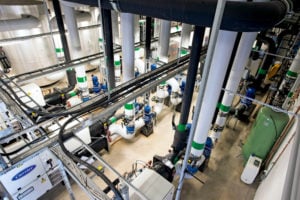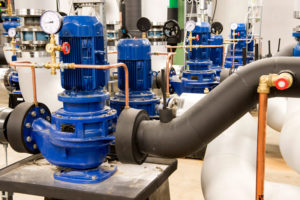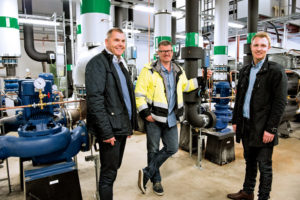The neighborhood of Nya Krokslätt in Gothenburg, Sweden, has a new energy-efficient solution for heating and cooling all buildings, thanks to a borehole thermal energy storage center. Although the building area in the new neighborhood will increase by 65 percent, the goal is that the amount of energy purchased for the area will decrease by 10 percent. Xylem’s Lowara e-LNE In-line pumps were selected to distribute heating and cooling from the storage center.
The new neighborhood, which will be built next to the existing area of Krokslätts Fabriker, will include rental housing, condominiums, offices, shops and preschools. Together these two areas cover 100,000 square meters, of which about 45,000 will be the new neighborhood that will be built over the next five years.
Reducing the amount of purchased energy
The real estate company Husvärden AB is responsible for the new energy-efficient neighborhood of Nya Krokslätt. The goal for the neighborhood is that the new buildings, together with the existing buildings in Krokslätts Fabriker, will be able to meet future energy goals without affecting the area’s economic sustainability. This means that although the building area will increase by 65 percent, purchased energy must decrease by 10 percent. This has been achieved by using solar cells to produce electricity, by creating a common heating system for new and existing buildings, and by using excess heat from offices and businesses to heat the homes in the area.
The technology consulting firm Bengt Dahlgren AB has worked on the project with Husvärden AB for several years.
“We had discussions early on about how to heat and cool the buildings as energy efficiently as possible,” says Jacob Pontusson, an energy and environmental consultant at Bengt Dahlgren AB. “The options were to either go on as before like with Krokslätts Fabriker, buying into the district heating and having local cooling systems in the different buildings, or investing in a central system and connecting the existing buildings with the new. We calculated the effects of both options and concluded that having a centralized system would be the best option both environmentally and economically. The biggest advantage of a central system is that you can move excess heat around the area instead of losing it.”
Storing excess heat

The solution was to build a new borehole thermal energy storage center for heating and cooling the entire area. The center was built in the new parking garage in the neighborhood. Under the building, 80 boreholes have been drilled for storing heat. Later on, an additional 40 boreholes will be drilled, making the facility one of the largest of its kind in Sweden. The boreholes are used to store excess energy from the buildings in the summer, which will then be used in the winter when the buildings need to be heated. The company Installationsbolaget AB was responsible for all of the piping and pumping installations in the storage center.
“This is a very complex system,” says Dennis Juhlin, project manager at Installationsbolaget AB. “There was not much space in the storage center, and a lot of pumps, pipes and tanks had to be installed. This is why it was important to make a good plan to design, assemble and install everything in the right order. To choose the pumps we needed for the center, we put them out to bid and contacted various pump suppliers. After making a life cycle cost evaluation, Xylem’s pumps proved to be the most energy efficient and best solution.”
Energy-efficient circulation pumps
At Xylem, Niklas Meyer is the account manager for the project, and Emil Wallander the technical manager.
“We decided to use our new line of energy-efficient circulation pumps, the Lowara e-LNE In-line pumps,” says Meyer. “It is a relatively new pump series that meets the tough energy regulations that came into effect in 2015. With our pumping solution, Nya Krokslätt is expected to save approximately 175,000 kWh per year.”

The project involves circulating a lot of water, and in total 19 Lowara pumps were installed in the storage center. Most of the pumps are used to distribute heating and cooling to all of the buildings in the area, while three of the pumps are used to push the excess heat down into the boreholes.
“Krokslätts Fabriker previously bought district heating and had local cooling systems,” Jacob Pontusson says. “If a house had excess heat, it cooled down and the heat was lost. With the new borehole thermal energy storage center, excess heat can now be moved around the neighborhood. Three large cooling machines act as heat pumps that can provide both cooling and heating. There are also large tanks for storing excess heat over the day, while the boreholes are used for storing heat for longer periods.”
Successful installation
The installation started in the fall and now the entire facility is up and running.

“It has been an exciting project, with a lot of challenges to fit all of the equipment in a small space,” Pontusson says. “We still have more to do. There will be a total of 120 boreholes in the area when we are done.”
“Our team did a very nice job on this installation, which involved installing a lot of equipment close together,” says Dennis Juhlin. “Everything has gone according to plan and we kept the schedule. I also want to highlight our good cooperation with Xylem. They have given us great support both on the phone and on site.”

